
by Mary Salinas | Apr 21, 2016
Recently, a home gardener brought in some strange looking new leaves on his camellia. The youngest leaves were thick and fleshy and looked more characteristic of a succulent type plant than a camellia. What’s wrong with these leaves?
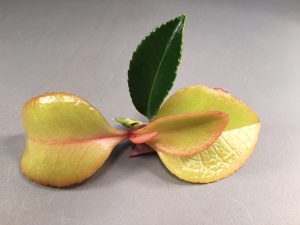
Camellia leaf gall infection resulting in fleshy light green and pink leaves. Note the contrast with a healthy uninfected leaf. Photo credit: Mary Derrick, UF/IFAS.
The culprit is a fungus Exobasidium camelliae whose spores are carried by the wind in search of camellias. This fungus infects camellias, especially sasanquas; it will not infect any other plant species. The disease it causes is known as camellia leaf gall and is most commonly seen here in the Florida panhandle in April. The frequent wet weather this winter and spring created favorable conditions for disease development.
The symptoms of the disease are easy to distinguish and really stand out against the typical dark green leaves of the camellia. Leaves become thick and fleshy and the color ranges from light green to cream to pink. As the disease progresses and the galls mature, the lower leaf surfaces of the leaves will peel away to reveal a white underside laden with fungal spores. Wind and rain will take these new spores to other parts of the camellia or other camellias in the vicinity where they will lay dormant and cause infection the following spring. Eventually the galls will turn brown and dry up.
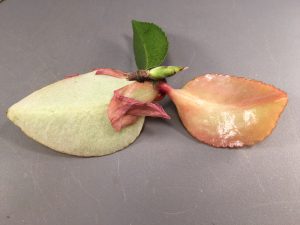
The underside has pealed away revealing white fungal spores. Photo credit: Mary Derrick, UF/IFAS Extension.
Camellia leaf gall is not a serious disease that requires chemical intervention for the homeowner. Simply remove the galls and put them in the trash. The earlier you remove the galls the better; the risk of further infection can be reduced if the galls are removed before the undersides peel and expose their spores. Any that have fallen to the ground can spread the disease and need to be removed.
For more information:
Camellias at a Glance
Camellia Leaf Gall
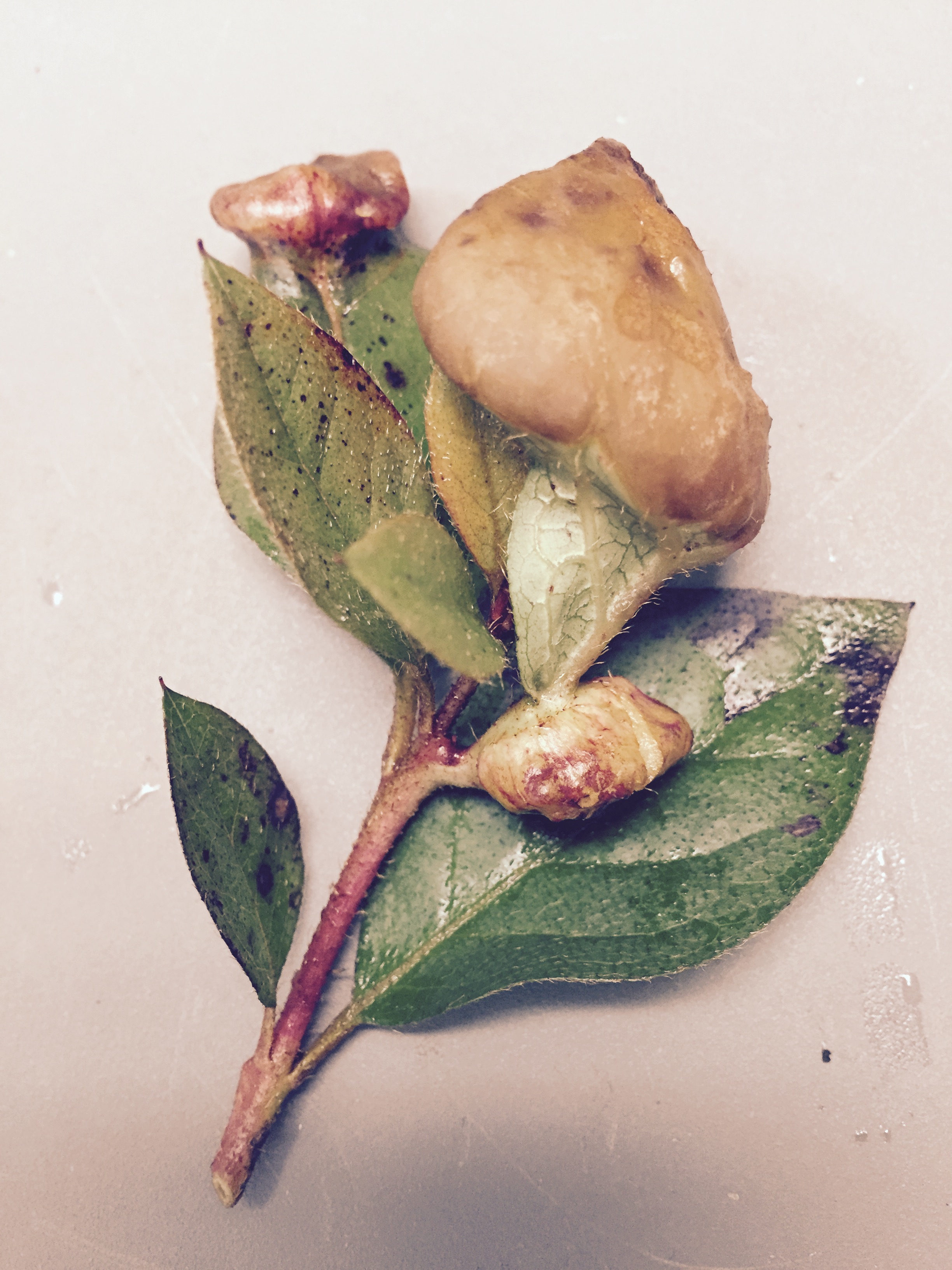
by Mary Salinas | Apr 28, 2015
Fleshy distortions are appearing on some azaleas this time of year. What is responsible for this? A fungus, Exobasidium vaccinia, likes our cool, wet spring weather and infects azalea leaves and flower petals. This disease likes a cool, wet, shady and protected environment.

Azalea gall. Photo credit: Mary Derrick, UF/IFAS Extension.
The infection causes the plant to form large, fleshy, distorted tissues known as galls. The galls produce a white powdery coating that is capable of producing more spores that will continue to cause new infections if left on the bush. The gall will eventually turn dry and brown and fall to the ground. Sometimes there are only a few leaves infected or there may be quite a few on a bush.
Not to worry – this is not likely to cause significant harm to your azalea. The best plan of action is to remove the galls as soon as possible and dispose of them in the trash or burn them to prevent reinfection of your plants. Avoid any irrigation that sprays water onto the leaf surfaces as the moisture creates a favorable environment for disease. Once you see this gall forming, there is no chemical control that is effective.
For more information on caring for your azalea:
Azaleas at a Glance
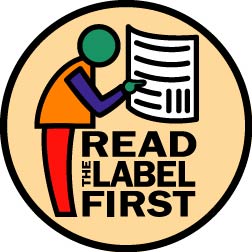
by Julie McConnell | Jul 22, 2013
 When you contact your local extension office for pest control recommendations you will likely hear “follow the label” over and over again. So, why do we emphasize the pesticide label so strongly when talking to both homeowners and landscape professionals?
When you contact your local extension office for pest control recommendations you will likely hear “follow the label” over and over again. So, why do we emphasize the pesticide label so strongly when talking to both homeowners and landscape professionals?
There are many important reasons why you should always read and follow label instructions.
- The Label is the Law – using a pesticide in a manner that is inconsistent with the label is a violation of the Federal Insecticide, Fungicide, and Rodenticide Act (FIFRA). Using a product inconsistent with the label includes, but is not limited to: rate of application, use on site not labeled for control, use on plants/lawns not labeled, frequency of application, method of application, distance from water sources, etc.
- Safety of Humans – using a product incorrectly can cause harm or even lead to death
- Safety to Non-target Organisms – this includes non-target insects, reptiles, birds, fish, mammals, and plants which can lead to negative impact on environment and economy
- Effectiveness of Product – millions of dollars are spent to figure out the most effective way a product works best, follow their instructions! (remember the manufacturer wants the product to be effective so that you’ll recommend to others and buy it again)
- Increased Resistance Decreases Control – improper application and a failure to rotate products as part of an integrated pest management program can increase likelihood of resistant pest populations
Before shopping for any pesticides, do some research:
- Has the pest been identified properly? What life cycle stage is the pest at? Most pesticides have different levels of efficacy depending on life cycle of target. For example, glyphosate works best on young plants that have not yet flowered. Your local extension office can help with identification and timing of control methods
- Can you control the pest with cultural practices such dethatching, irrigation, fertilizer, or mowing height changes? Start with the least toxic method of control and only work up if ineffective
- Read the label before you buy to be sure that it is labeled for your plant /lawn, target pest. The label will also tell you what equipment you’ll need to mix and apply and safety equipment. If product is not ready to use, be sure you can follow mixing and application procedures safely
- Are there particular environmental precautionary statements that are relevant to your site?
- How much do you need? Have you measured the area for treatment? Just as you don’t want to make multiple trips to the store, you also do not want a lot of excess chemicals on hand. They have to be stored or disposed of according to label instructions, too
For more information about pesticide labels read EDIS PI-34 Interpreting Pesticide Label Wording.
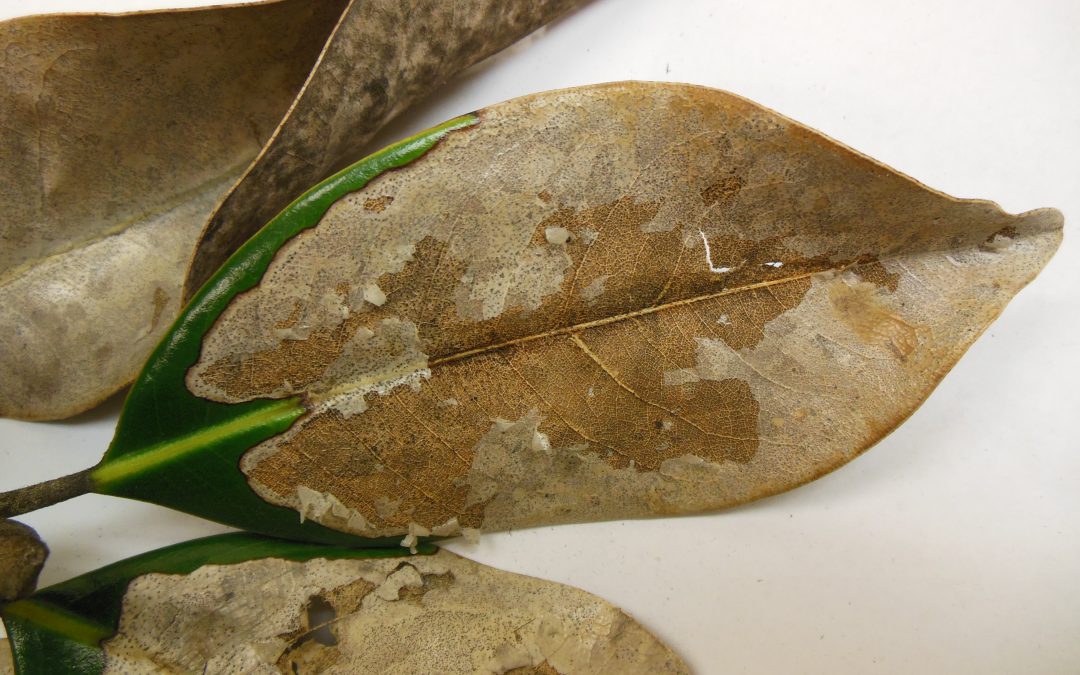
by Mary Salinas | Jun 21, 2013
We love our native magnolias in part because they are tough, easy to care for trees. The mainstay of southern gardens, they grace us with attractive thick, waxy leaves year round and sublimely fragrant and graceful blooms.
However, this past spring brought conditions that encouraged a fungal leaf disease known as anthracnose, most noticeably on the southern magnolia, Magnolia grandiflora. Affected leaves develop large irregular dead patches with a clearly defined border. The dead patches are a brownish gray and will flake and eventually deteriorate and fall away from the rest of the leaf. Fortunately it is rare for the disease to affect all branches of the tree and infection is somewhat spotty as you can in the photograph below.
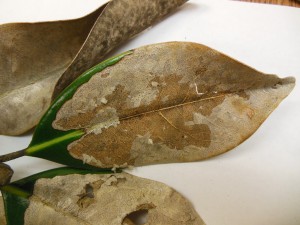
Credit: Mary Derrick, UF/IFAS Extension
Conditions that favor the development of anthracnose in magnolia are the cooler, moister conditions that the panhandle experienced this early spring. Spores overwinter on affected branches and in leaf litter and travel to their new hosts through rain, wind and splashing water.
View this article to learn more about the Southern Magnolia
[important]The good news is that this disease is rarely a serious threat to the long term health of the magnolia. [/important]
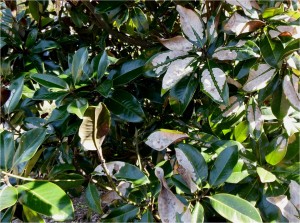
Credit: Mary Derrick, UF/IFAS Extension
But in order to avoid another infection next spring, remove and dispose of as many affected leaves as possible from the tree and certainly those that have fallen. Avoid irrigation that wets the leaves because the consistent presence of moisture on the leaf is a perfect incubator for anthracnose. Ensure that there is sufficient air flow around the trees. Fungicidal treatment is generally not warranted.









